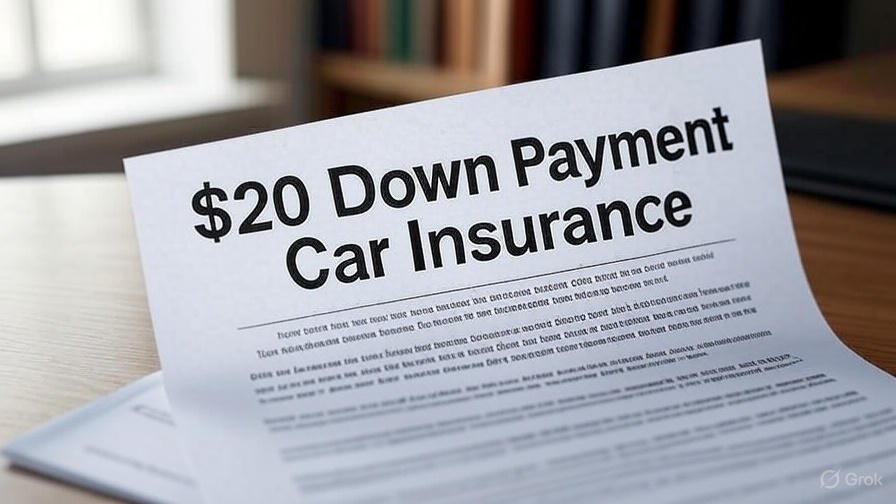What Is $20 Down Payment Car Insurance?
A $20 down payment car insurance policy allows drivers to initiate coverage with a minimal upfront cost, a stark contrast to traditional plans requiring a full month’s premium or more. Offered by select insurers, this option spreads the remaining balance across affordable monthly payments, catering to those with limited initial funds. It’s designed to meet minimum state insurance requirements while easing financial burdens.
However, the total cost may exceed standard plans due to adjusted premiums. This trade-off aims to balance accessibility with insurer risk management, making it a topic of interest in the insurance industry.
How Does It Work?
The process begins with a risk assessment by the insurer, evaluating factors like driving history and vehicle value. The $20 down payment activates the policy, covering a portion of the first month’s premium or administrative fees. Remaining payments are scheduled monthly, often with auto-pay options for convenience.
- Risk Evaluation: Insurers analyze credit scores, accident history, and car type to set terms.
- Payment Plan: The low initial payment is followed by higher monthly installments, potentially with fees.
- Immediate Coverage: Proof of insurance is provided instantly, ensuring legal compliance.
According to a 2024 report by the National Association of Insurance Commissioners, low-down-payment plans have helped 15% more low-income drivers gain coverage in the past year.
Who Qualifies for This Plan?
Eligibility hinges on specific criteria set by insurers. While aimed at low-risk drivers, some providers extend offers to higher-risk individuals with tailored terms. Key factors include:
- Driving Record: A clean record boosts approval odds; recent violations may disqualify.
- Credit Score: Scores above 650 are preferred, though some accept lower scores with higher rates.
- Vehicle Type: Older or less valuable cars are often eligible due to reduced risk.
- State Laws: Availability varies, with some states setting higher minimums.
Low-income drivers, students, or those facing temporary financial hardship often qualify, provided they meet basic standards. High-risk drivers with DUIs or multiple claims may need alternative solutions.
The Application Process Explained
Applying is user-friendly, often online or via agents. Follow these steps:
- Collect Details: Gather personal info, driving history, and vehicle data.
- Get Quotes: Use comparison sites or contact insurers for $20 down payment options.
- Apply: Submit the application online or with an agent.
- Pay Down Payment: Use a card or bank transfer for the $20 fee.
- Receive Proof: Get digital proof of insurance immediately.
Many providers offer instant approvals, ideal for urgent needs. Reviewing terms for hidden fees is essential to avoid surprises.
Benefits for Low-Income Drivers
For low-income individuals, this plan offers critical advantages:
- Low Entry Cost: A $20 start avoids draining savings, enabling coverage for work or emergencies.
- Legal Compliance: Meets state minimums, preventing fines or license issues.
- Budget Flexibility: Monthly payments align with limited incomes.
“This option has been a game-changer for low-income families, providing access to essential coverage,” says Dr. Laura Evans, a policy analyst at the NAIC.
Consistency in payments is vital to avoid lapses, which could lead to penalties or higher future rates. The U.S. Department of Transportation highlights that reliable transportation access is key to economic mobility for low-income communities.
Considerations and Alternatives
While beneficial, higher monthly premiums and fees can increase total costs. Drivers should:
- Compare quotes from multiple insurers.
- Explore pay-per-mile plans for low mileage.
- Check state assistance programs for high-risk cases.
Beware of scams promising “no down payment” deals. Verify insurers with the Insurance Information Institute.
FAQ: Addressing Common Questions
Is $20 down payment car insurance reliable?
Yes, from reputable insurers, but total costs may be higher. Verify with licensed providers.
Who qualifies for this plan?
Drivers with good records and decent credit often qualify; high-risk cases may face restrictions.
Can I cancel if needed?
Yes, but check for cancellation fees. Contact your insurer for details.
Conclusion: A Practical Solution
The $20 down payment car insurance option offers a practical entry into coverage, especially for low-income drivers. By understanding its mechanics—starting with a minimal payment and spreading costs—and eligibility criteria, individuals can secure legal driving privileges. The application is quick, and benefits are significant, though careful comparison is key. Stay informed with our Auto Insurance News for the latest updates as of July 26, 2025!
You may also read: Understanding SASSA Status Check for R350 Payment Dates: Key Insights
